
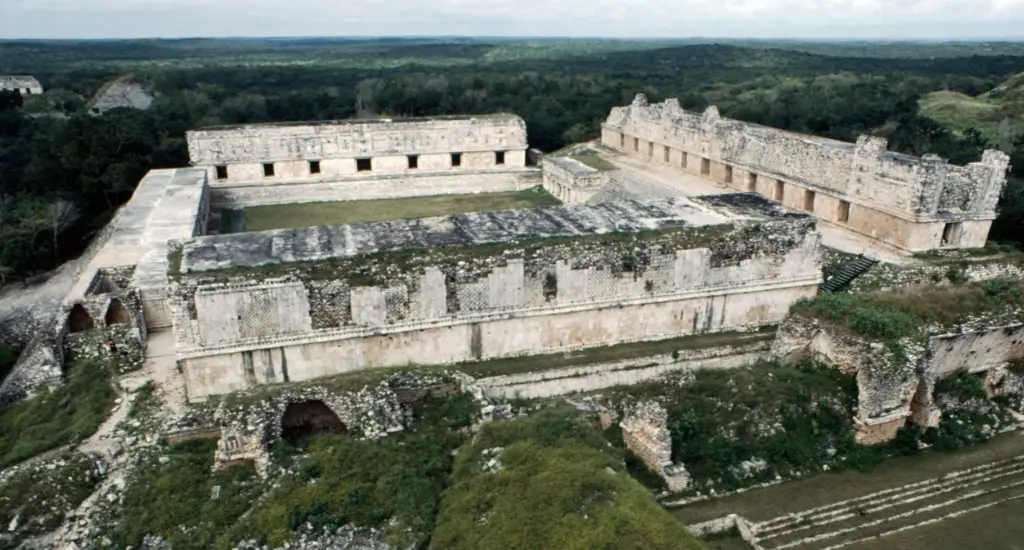
The Nunnery Quadrangle is a palatial complex located next to the Quadrangle of the Birds directly west of the Pyramid of the Magician in Uxmal. It is the kind of place that both casual tourists and esoteric symbolists can appreciate: opulently ornate and openly evoking the cosmology of the Maya. Its facades are fabulously tricked-out with well-preserved iconography conveying deeper meaning about the metaphysical makeup of man and the cosmos. Yet, the monumental ruins maintain a dignified silence.
The Nunnery Quadrangle was built in the 10th century under the direction of Uxmal’s most prolific governor, Lord Chaak, but in the 16th century its architectural elements reminded the first Spanish explorers of nunnery convents back home in Spain, hence the name. No nuns here! No, it’s all about the round-trip journey to the spirit world and how initiates were informed by didactic architecture cosmologically laid out to serve as a mystery school.
A study conducted by astronomer Anthony Aveni and the architect Horst Hartung reveals how the buildings and their entrance ways were used by the ancient Maya for astronomical observations. According to American anthropologist and leading authority on the Maya, Michael D. Coe, these cosmic universities were indeed used as schools for training astronomers as well as warriors, calendrical day keepers, the ritual priesthood and shamanic healers. It is also interesting to point out how the Governors Palace in Uxmal was recently found to be used for harvesting a number of medicinal plants.

The Nunnery Quadrangle in Uxmal is composed of four individual palaces each supported by an independent platform of different height from .20 meters to 6.69 meters and each unattached at the corners but laid out in a not-so-rectangular square to form an interior courtyard. Near the center once stood a small, square platform that served as a base for a stone sculpture representing a jaguar, but both have since been removed.
Each of the four main buildings that make up the Nunnery Quadrangle in Uxmal are treated in the traditional Puuc style typical of the region with a thin layer of veneer masonry and well cut stones. Unlike the smooth, plain lower register, the upper friezes are opulently ornate. Each of the facades differ in their unique decorative arrangement. Likewise, each of the buildings that make up the Nunnery Quadrangle in Uxmal differ from one another in terms of size, entrance ways, number of rooms, and configuration, all of which provided inspiration for the imaginative name given by the Spanish explorers.
Regardless of the differences in size and arrangement of its individual elements, the Nunnery Quadrangle still manages to produce the impression of unified whole with each of the individual components complementing each other.
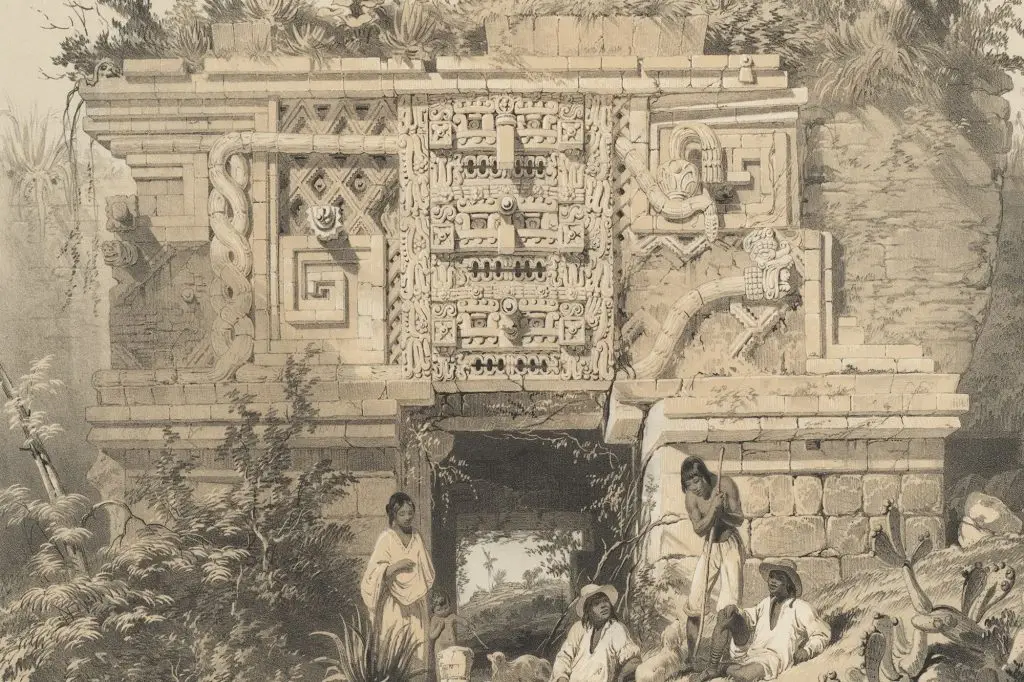

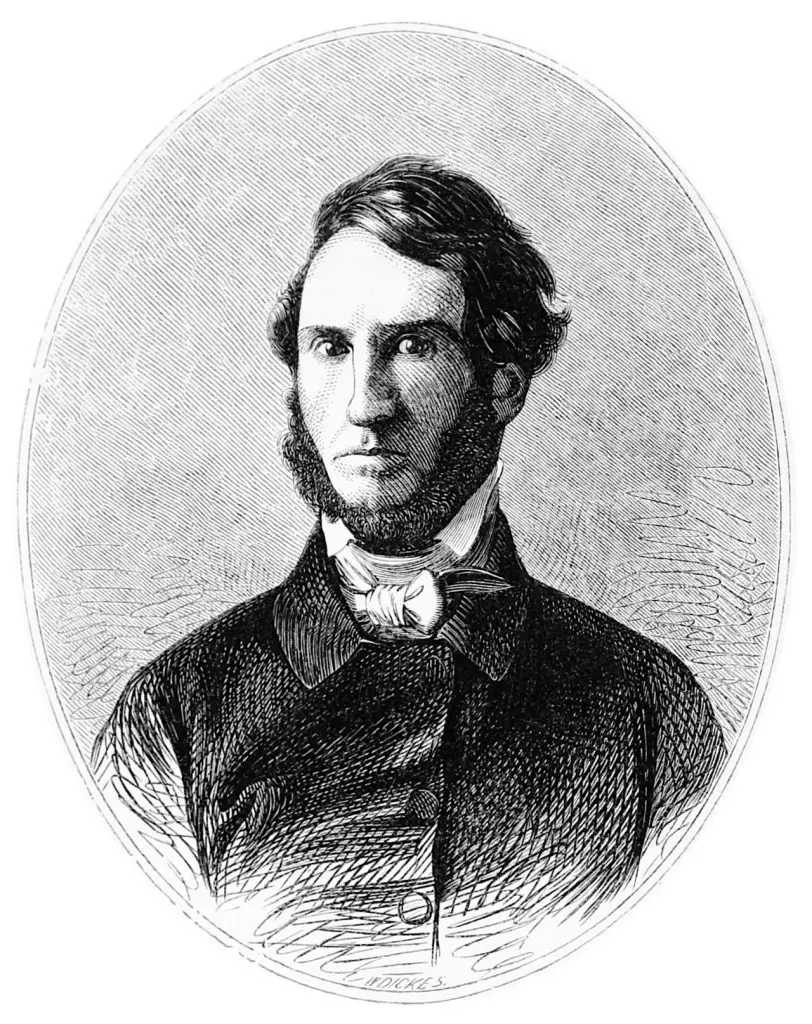
When explorer John Lloyd Stephens first investigated Uxmal in 1890, he pointed out how the Northern Building is built onto of a much older structure from an earlier period.
Authorities from INAH (National Institute of Anthropology and History) have recently removed a row of stones outlining the foundation for a dwelling near the center of the courtyard. The ruins appear to be a late addition, not made by the original builders of Uxmal. One wonders if this was perhaps a product of the Xiu family, whom Michael D. Coe, viewed as: “a Johnny-come-lately lineage of Mexican origin [central Mexico] that could not possibly have built the site.”
Michael D. Coe further explains: “The archaeological and epigraphic evidence testifies that Uxmal had emerged as a capital of a large, Terminal Classic state centered in the eastern Puuk between AD 850 and 923.”
According to Dr. Jeff Karl Kowalski, an expert on Maya art and architecture and leading authority on the ruins of Uxmal, the key monuments were built under the direction of the divine governor, Lord Chaak, during its second occupation in the Late Classic Period, between AD 890 – 915 and constructed to conform a cosmogram.
In the 1930s, a group of archaeologists and architects from Middle American Research Institute at Tulane University measured all of the buildings in the Nunnery.
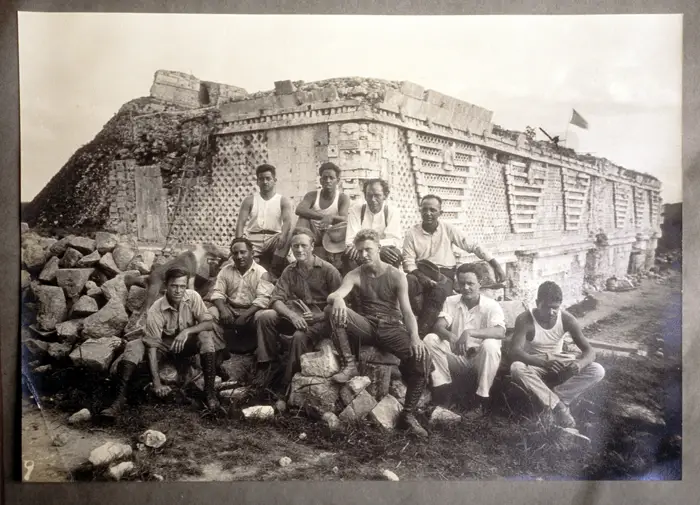
A more recent survey conducted by George F. Andrews, University of Oregon revealed several successive construction stages.
Based on his observations made between the 1970s and 1980s, the Nunnery Quadrangle in Uxmal appears to be the result of six major construction phases as outlined below.

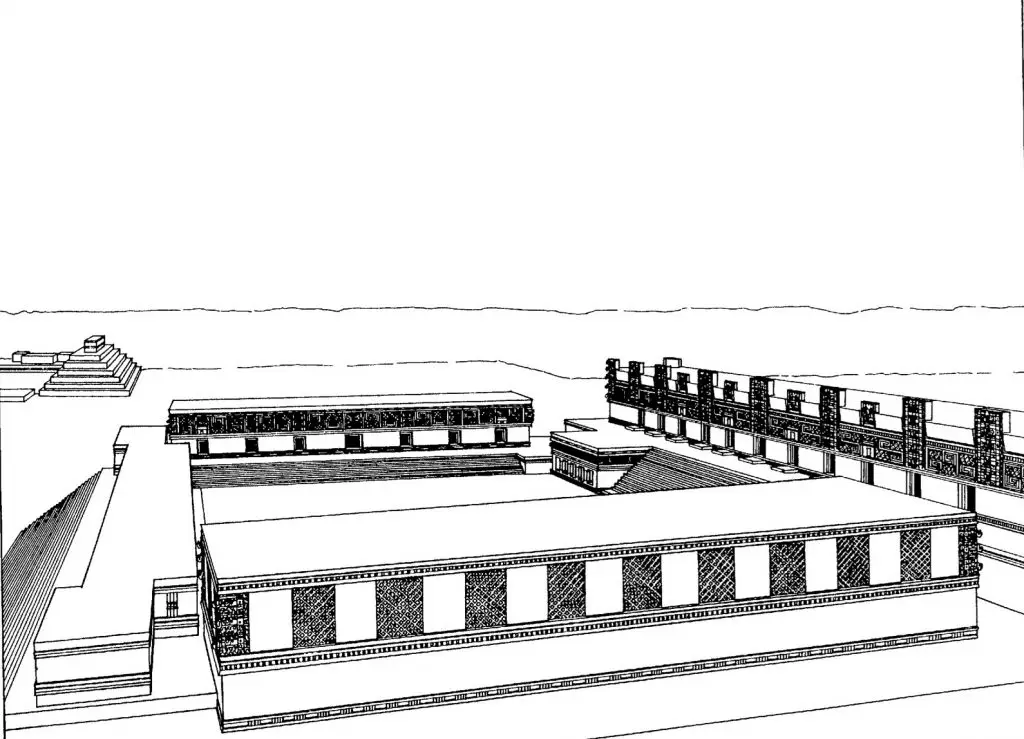
The six construction phases of the Nunnery Quadrangle in Uxmal are as follows:
Construction of South Building, not including offset rooms at east and west ends. Must also have included a stairway on south side, which may have been limited to central portion of present stairway.
Construction of inner North Building, together with supporting platform and some form of stairway on south side.
Construction of West Building, together with its supporting platform and stairway on court side.
Construction of East Building, together with its platform and stairway on court side. Portal vault through House of the Birds (West Building of the Quadrangle of the Birds) was either closed off or filled in due to the height of new platform on west side.
Construction of outer North Building, together with present monumental stairway on south side and buildings (Temple Y or Venus Temple to west and Temple Z to the east) at outer edge of platform on lower level immediately east and west of this stairway.
Construction of offset rooms at east and west ends of South Building and east and west rooms at south edge of Platform of North Building. Roofs of latter rooms are higher than level of terrace behind.
The grandeur of the Nunnery Quadrangle is slowly revealing its secrets.
The Maya intentionally produced geometric forms, but what was the reason for this? The Mesoamerican ontology consists of a four-part world view and a multi-layered universe.
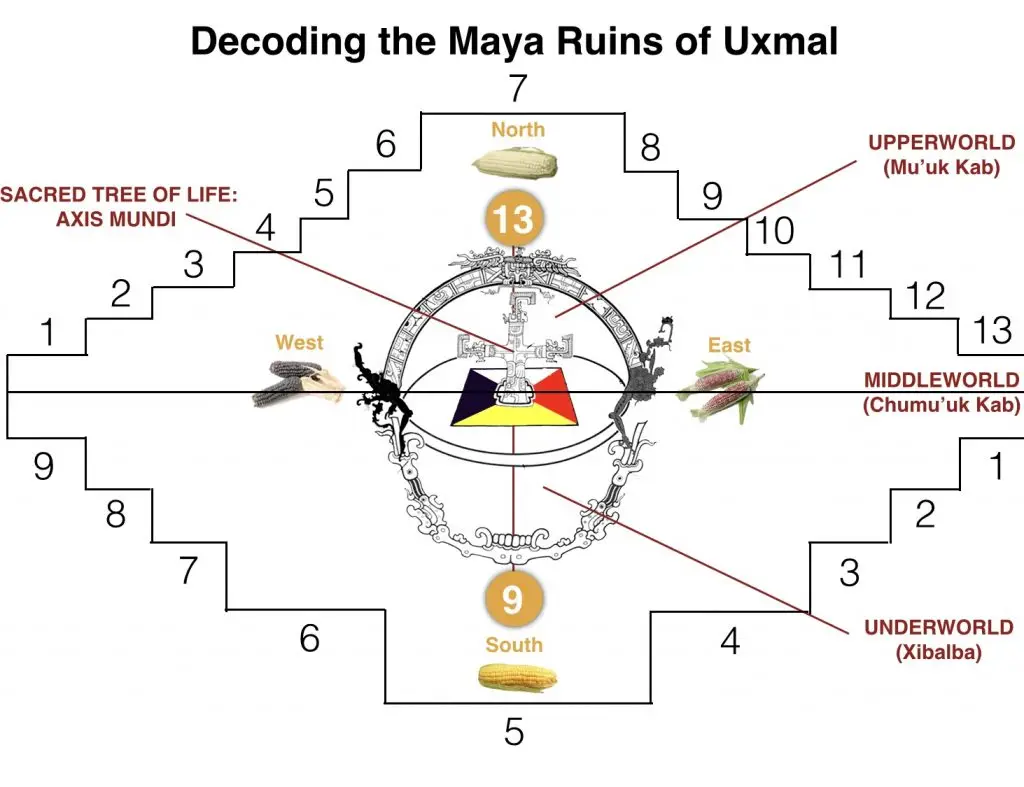
This was expressed by the Maya world tree of life, the Waka-Chan tree or axis-mundi which manifests in the physical form as a ceiba tree. This tree was at the center of the Maya world and corresponds to the cosmogram that is not only encoded into the architecture but also reflected in the symbolism of the Nunnery Quadrangle. An iconographic study by Jeff Kowalski suggests a cosmological layout for the Nunnery Quadrangle. German epigrapher, Nikolai Grube believes the different elevations represent a cosmogram.
I agree with both scholars and I have taken it a step further by showing the cosmogonic relationship between not only the Nunnery Quadrangle and the Ball Court in Uxmal but also the House of Turtles and demonstrate how the cosmology of the Maya is encoded in these structures which collectively served as a mystery school educating initiates about natural laws and principles.
The Nunnery Complex is a symbolists dream-come-true. While I can bring meaning to many of the motifs there is still much left to be discovered. Let us get started, shall we?
Although the interior courtyard can be entered from each of the four corners, the principle portal with its corbel arch lies in the center of the southern building, representing the womb of the world.
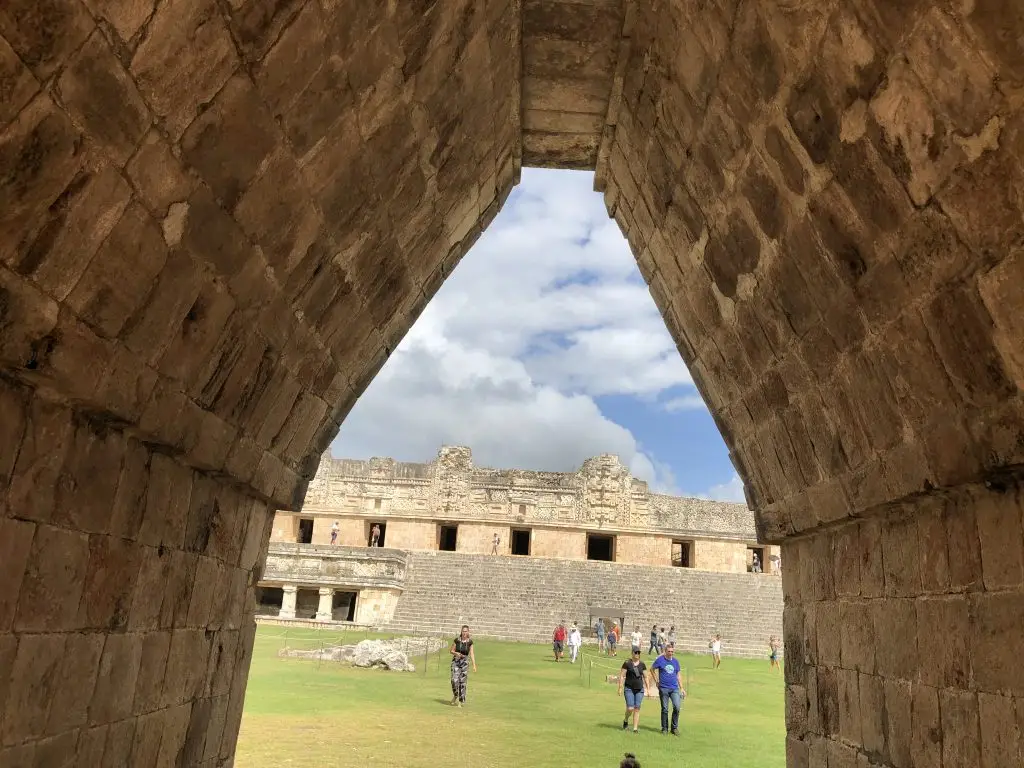
Access to this gateway is by means of a three-part stairway on the south side of the South Building, running its full length or from the through the vaulted arch in the south east connected to the Quadrangle of the Birds.
An acoustic experiment can be performed in the courtyard. By you can hear a reverberating echo common hinting at the advanced acoustic engineering of the ancient Maya. We always have fun with this during our esoteric symbolist tours of the Yucatan.
The court yard was the non-material made manifest in the cosmological layout and symbolized the axis-mundi of the Maya Middle world. It was the center of the ceiba tree whose whose 9 roots are seeded in the 9 levels of the underworld, Xibalba, and whose 13 branches reach into the 13 levels of the upper world. I suspect earth energies were most concentrated in the center and that is why the ancient architects raised the earth into a mound and eventually built their terrace on-top.
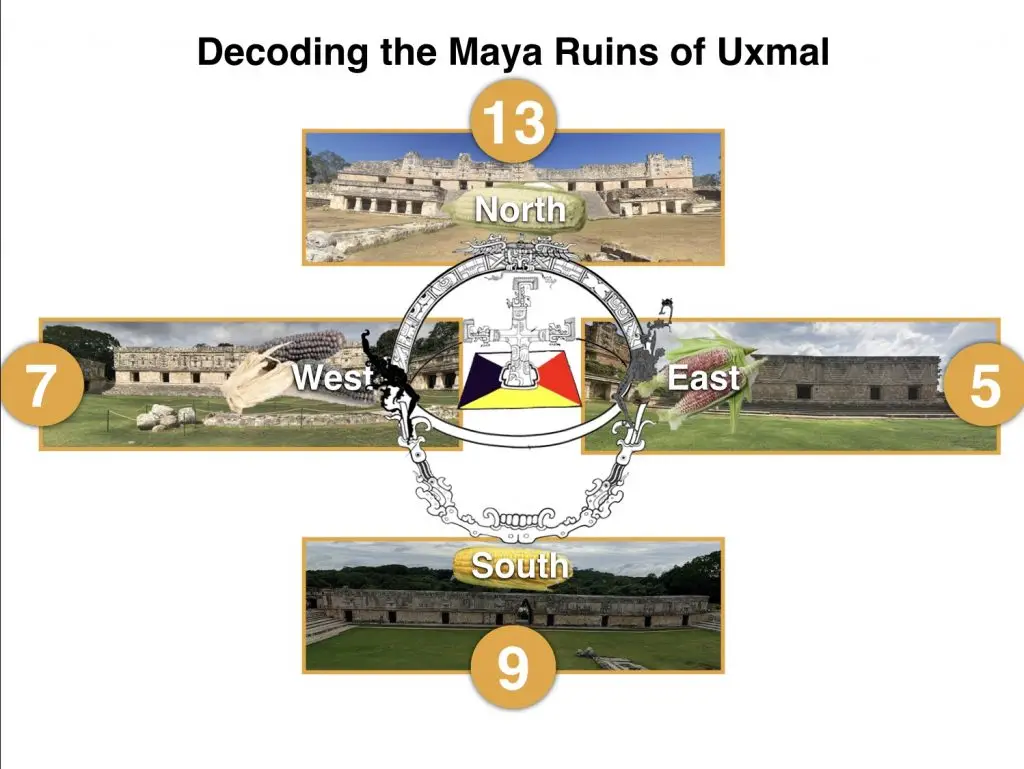
Each of the four cardinal directions are represents by an independent building just as the each of the four cardinal directions are associated with a different color of corn.
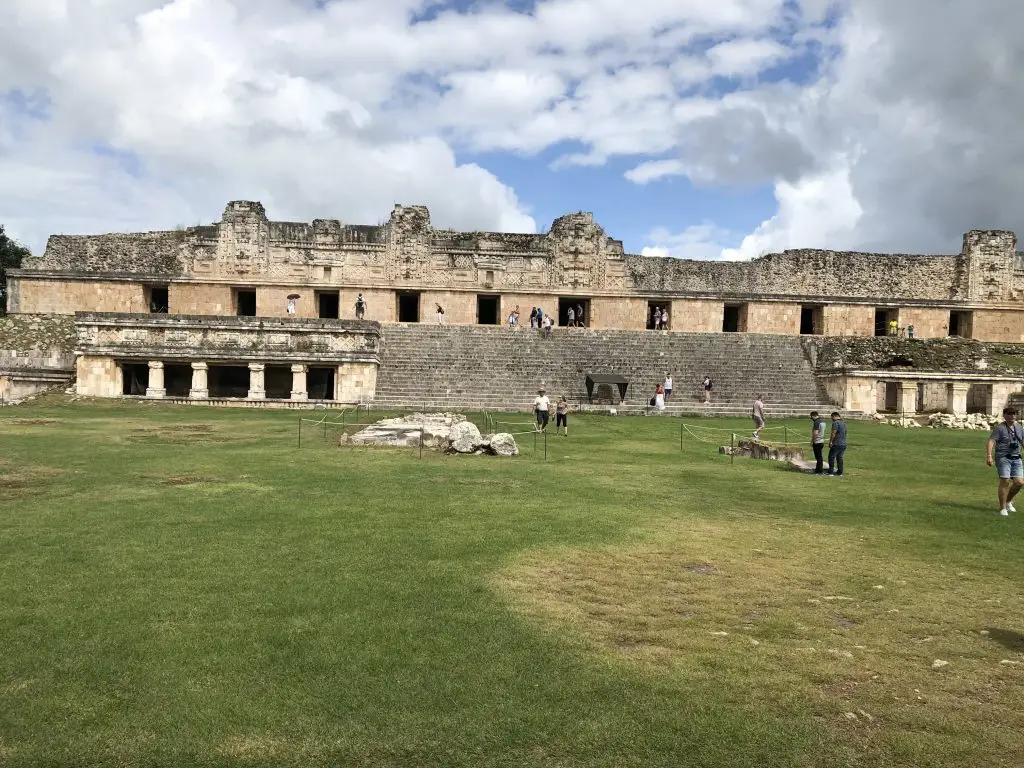
You can access the North building from a modern metal staircase on the Northeast corner however, the principle point of access would have been the monumental central staircase leading from the courtyard where a restored stela sits in situ. Its inscriptions are poorly preserved and no longer legible.
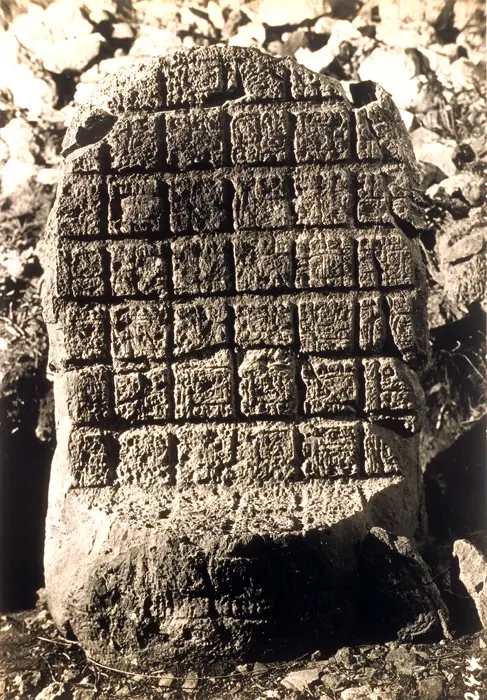

There are two buildings known as Temple Y or Venus Temple and Temple Z at the base of the North Building flanking the center stairs.
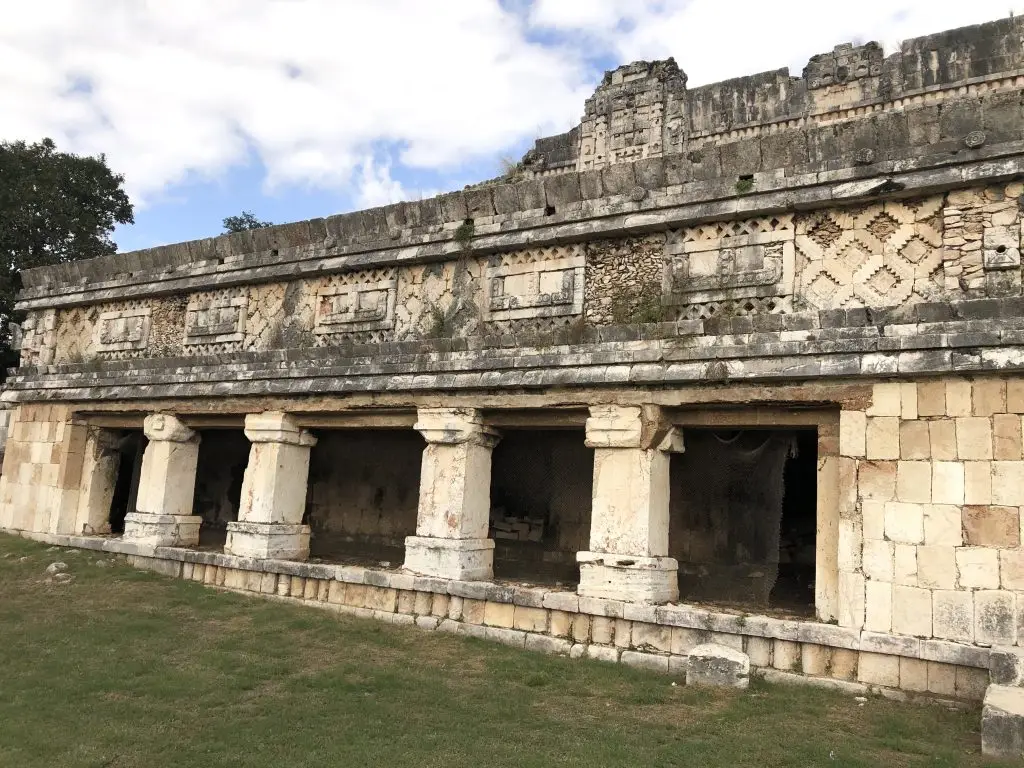
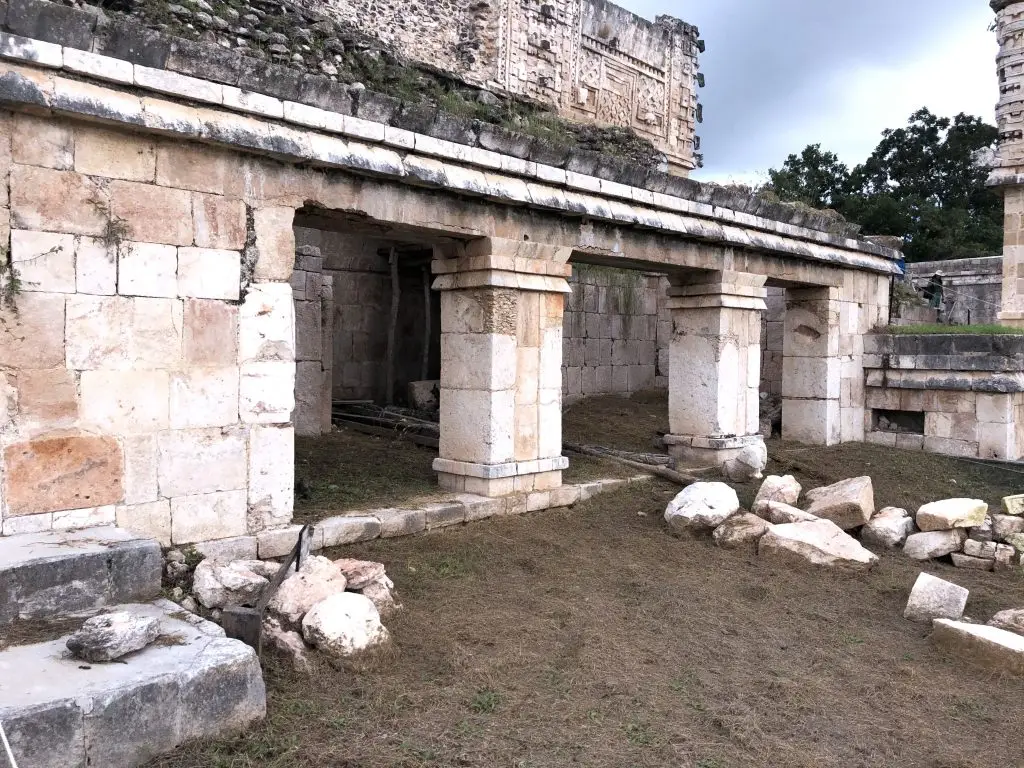
Temple Y to the east (left) is supported by court columns and may have been used as a tlamacazcalli “priest house” (In the Nahuatl language), which served as a theological graduate school for advanced priests in training. According to Michael D. Coe, these priests were “instructed in all aspects of religion, including the calendar, the rituals, the songs which were to be chanted over sacred books, and the glorious past of the nation”.
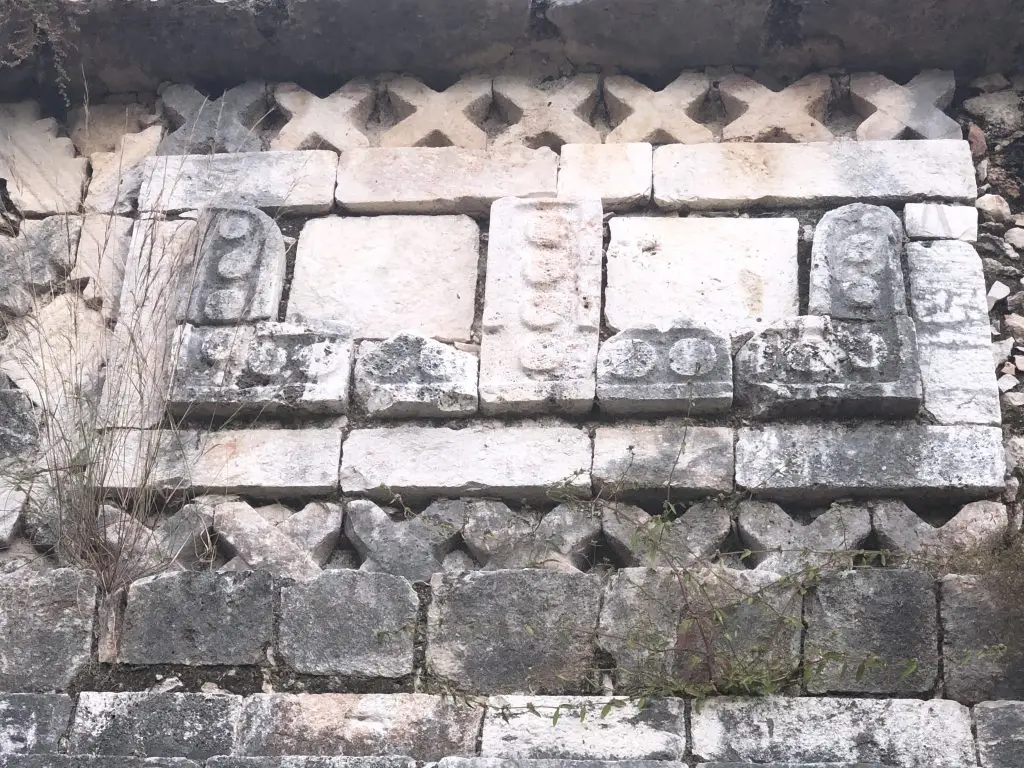
Unlike Temple Y which depicts glyphs symbolizing the planet Venus on its exterior, Temple Z to the west (right) has no ornamentation and only two columns. This was probably associated with the telpochcalli or “House of Youths” (in the Nahuatl language), a military academy for warriors in training. A poorly preserved painting was discovered on a capstone inside the temple by the Tulane University on an expedition in 1930. It represents partial calendrical dates from 906 to 907 A.D.


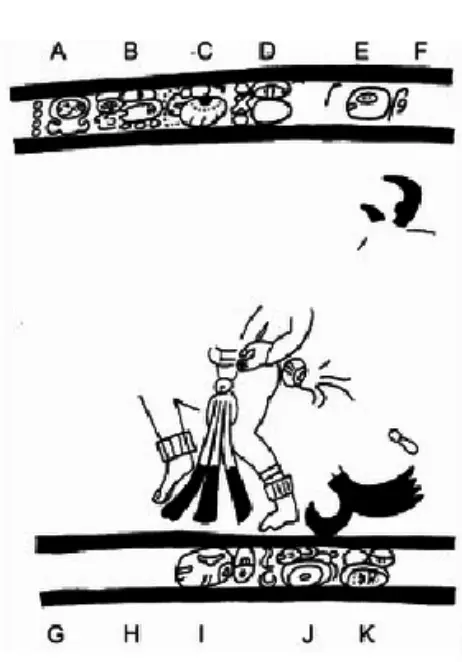
The North Building is the largest and highest of the four main buildings affording spectacular views overlooking the entire site from its terrace. The North Building is 81.44 meters long and 8.20 meters wide with a total of twenty six rooms. There are thirteen exterior entrances, corresponding to the number of levels of heaven in the upper world of Maya and the building stands on the highest elevation (about 6.69 meters high), affirming the ruling elite’s alignment with divinity.
The frieze is decorated with stacked, long nosed Chaac masks crowned by Tlaloc, associated with Teotihuacan in central Mexico, bound captives, owl, dual headed serpents, dual headed jaguar throne, geometric spirals, corn, and phallus.
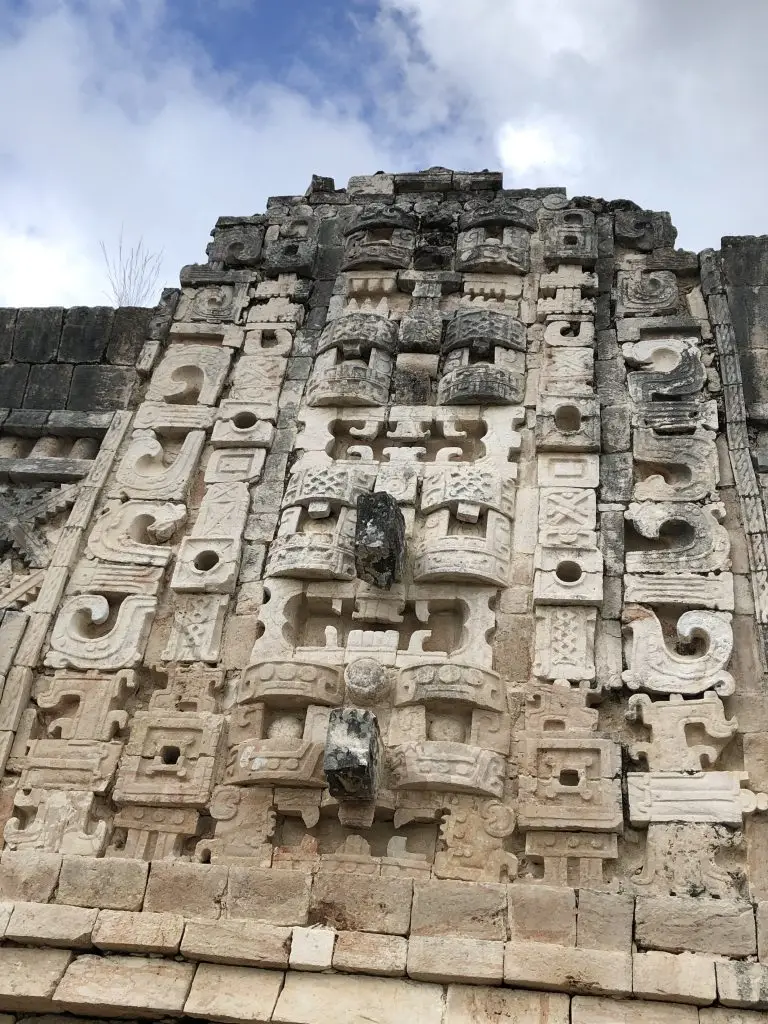

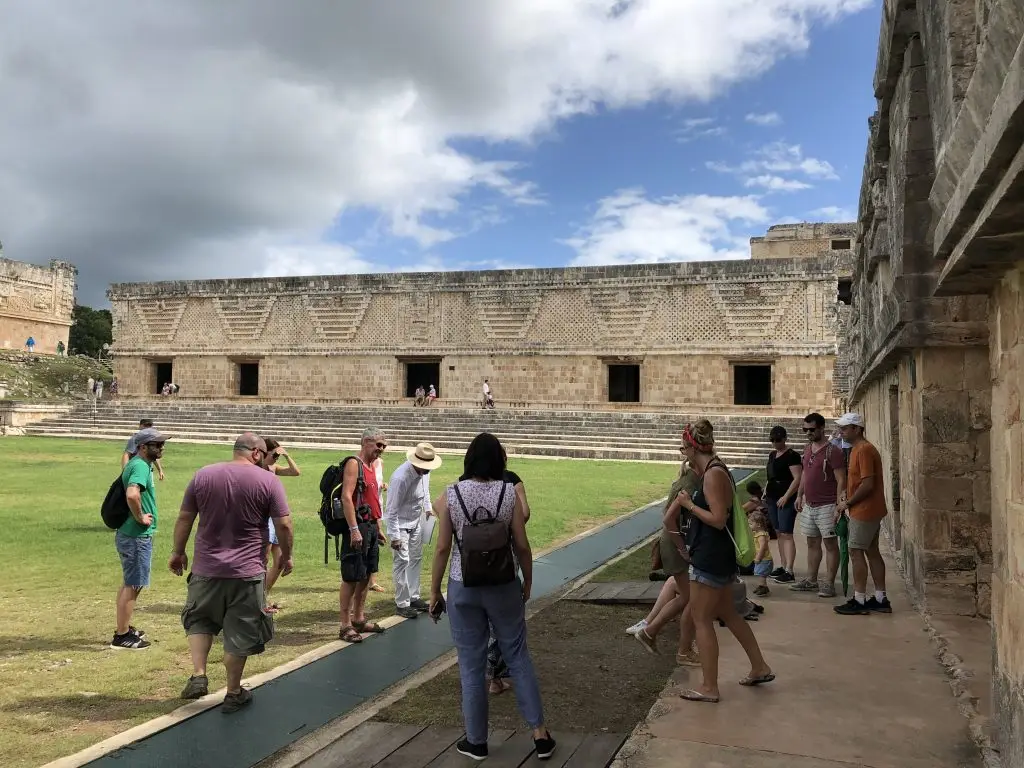
The eastern building is 50 meters long and supported by a platform about 2 meters high, with stairways on the court side running the full length of the court yard. The building is composed of 7 interior rooms with only 5 entrances, which surely convey a message, but what could it be? Our goal is to unravel the symbolic meaning.
The number 5 was the number of Love, new beginnings in the Pythagorean mystery schools because it was the first time the male number 2 came together with the female number 3. My mentor, the late symbolist author and rogue Egyptologist, John Anthony West would inform how Love has many connotations therefore 5 should be considered the number of potentiality. In Egypt, The number 5 was associated with Horus or Heru on the horizon in his role as the principle of return to the source. Thus the sun emerges from the underworld and rises in the east each morning.

Michael D. Coe points out how “The East Building has mosaic elements reflecting the old war cult of Teotihuacan, where tradition had it that the sun was born; thus this may also be Middleworld, the place of the rising sun” lending weight to my symbolist interpretation of the Uxmal ruins and the ancient architects use of the number 5 for the entrances on the East Building.
The mosaic elements also provide a clue for the function of the East Building which likely served as a telpochcalli for the offspring of the commoners who serve as warriors.

Above the central entrance and at the two flanking edges three Chaac masks are stacked vertically representing the Mayas three tier view of the upper-world, middle-world and underworld.


The remaining motifs are distinctly arranged in six groups of eight double haded serpents extending in length from bottom to top crowned by the head of an owl, symbol of wisdom, war and death. Each of the six groups are imposed against Puuc style lattice patterning.
Jose Diaz-Bolio believes the geometrical lattice work as well as all of the geometrical symbols of the Maya represent the scales and positions of the crotalus durissus or Ahau Can “Lord Serpent”, which for the builders of Uxmal was a religious entity symbolizing the principle that gives regularity and harmony to life.
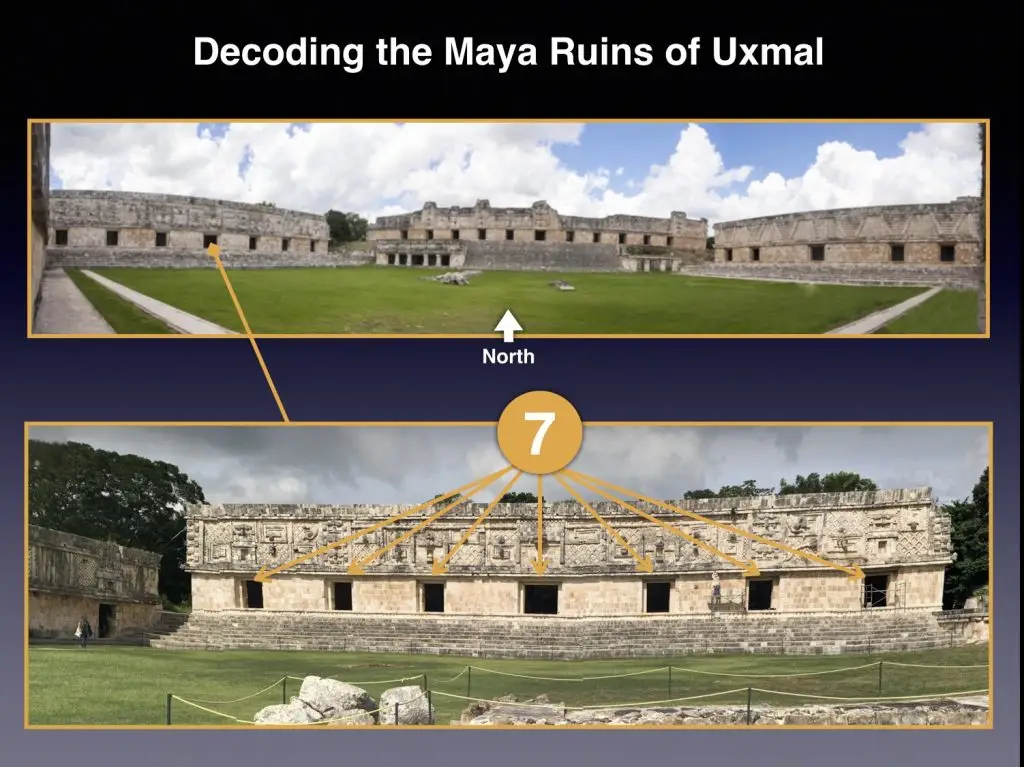
The West Building of the Nunnery Quadrangle rests upon a platform about 2 meters high. The building is 53.8 meters long and 10.51 wide with a total of 14 chambers in two parallel rows of 7 rooms corresponding to the seven exterior doorways representing the amalgamation of the Hermetic axiom “As above, so below” with a central axis mundi and 4 cardinal directions. Michael D. Coe reminds us that “7 is the mystic number of the earth’s surface”. It is also considered the mystic number of man for the same reason, the three dimensional shape of the cube: six sides, with the seventh element of space inside.
“Seven signifies the union of spirit and matter, of Three and Four”
- John Anthony West, symbolist author of The Serpent in the Sky: The High Wisdom of Ancient Egypt Tweet
In the Hindu Tantric system of numbers, Sapta represents the 7 chakras also known as the 7 major physic centers in the Rosicrucian tradition and correspond to seven musical notes of Indian classical music. There are also 7 operations in the alchemical tradition that the alchemist may perform to achieve the philosophers stone. In Tibetan Buddhism, the sold rests in an intermediate stage after a period of 49 days,which is 7 x 7. The Pythagoreans referred to 7 as the Septad and believed it was “worth of veneration” and their teachers, the ancient Egyptians valued 7 as the eternal number of life. It is interesting to point out that the Egyptians associate “death” (or eternal life) with the west. The West Building of the Nunnery Quadrangle is were the sun “wested” or went to be swallowed by the underworld represented by the Southern Building of the Nunnery Quadrangle with its 9 entrances. 7 is the number of progress and represents completion of a cycle, the cycle of the sun which set in the west. Therefore, it becomes easy to see why the number 7 seems sensible for the number of entrances on the Western Building of the Nunnery Quadrangle.
Further, the figure of the Pawahtun – the earth God as a turtle – implies the Middle World, but it could be argued that this sculpture as well as the intertwined plumed serpents were added at a later date as Alberto Ruz and F. De Molina believed. They posited that the applied sculptures were added when Toltec influences from Central Mexico, and the Xiu invaders arrived at Uxmal. However, this can not be the case as George F. Andrew has explored this idea and pointed out how the applied sculptures are not secondary additions but instead integral parts of the Late Uxmal style.

The upper facade is full of mosaics including stacked, long nosed Chaac masks at the corners and looming over doorways, complex lattice work, large stepped frets make up geometric spirals bearing a resembles to the Maya glyph for clouds and are thought to represent the same. I can understand that point, but another view I encounter was that of Miguel Angel Vergara, who believes they represent the alpha and omega of the Maya cosmogenesis.
A human figure is depicted with perforated phallus, typically a symbol of fertility but here it represents a ritual. The bone of a stingray was used by shamanic rulers to pierce their member in order to extract blood which would drip onto parchment to be burned. The clouds of smoke would then reach from sky from earth establishing a divine union.
The facade also features a human emerging from the mouth of a vision serpent establishing the rulers of Uxmal’s connection to the divine by representing the principle of return to source. We also find this theme at Labna and artifact known as the Uxmal Queen which was discovered inside the Pyramid of the Magician in Uxmal now featured on display in the Mayan Museum in Merida.
A plumed serpent, a symbol of divine duality is intertwined across the length of the facade. The Maya understood that while the venom of the serpent was harmful, snake meat serves as an antioxidant. That which can harm can heal – a basic belief in homeopathic medicine.
Given what is reflected in the symbolism this building likely served as a calmecac, a school for shaman and priests where rituals were carried out.
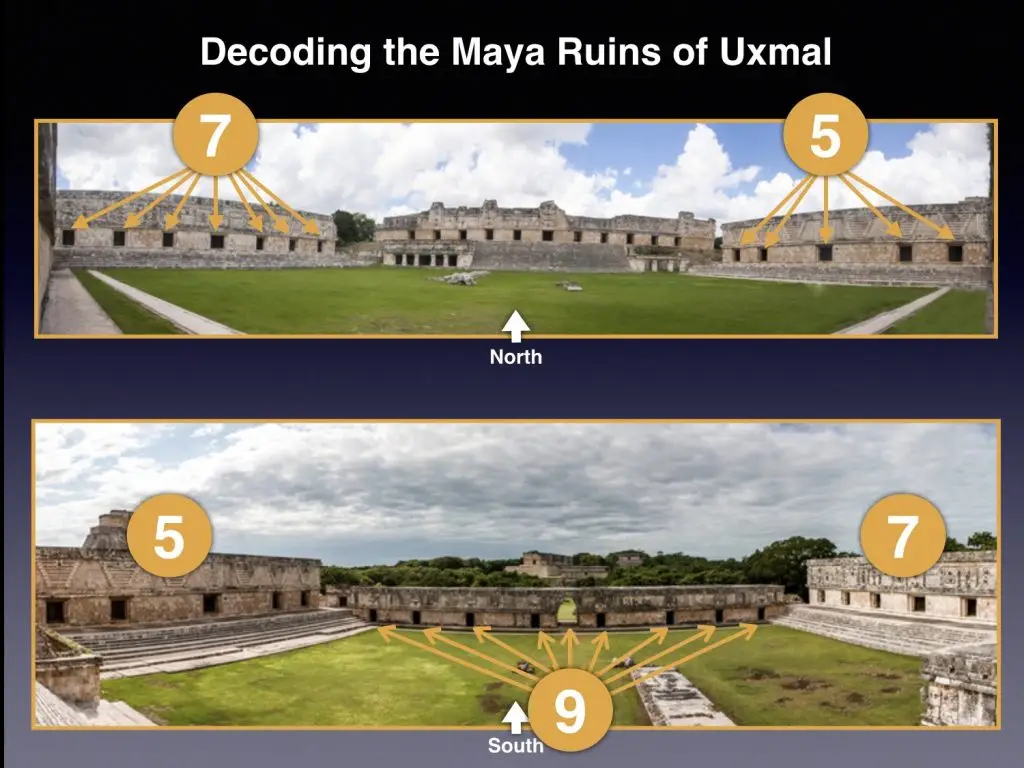
Unlike the other buildings which have stairways on the court side, the South Building is only a single step high on the court side of the lowest building in the group. Including the principle portal the building has nine exterior doorways corresponding to the nine levels of the Underworld or Xibalba.
On the upper east side of the vaulted arch red hand prints were discovered when archaeologists removed the polychrome stucco finish. Red handprints can be found on the walls of a number of Maya sites. According to some scholars, it is possible pilgrims from foreign lands left permanent records of their visit. What a way to leave your mark!

According to Jeff Kowalski they actually symbolize the creator god Itzamna, whose title was Kabul, “The Celestial Hand” and whose hands were red-hot in order to administer healings. However, the Red handprints may also be attributed to the Descending God linked to Venus. I was told by a local shaman that everything we need to commune with the gods is already inherit in our hands.
The upper facade includes typical Puuc motifs: lattice patterning with traditional thatched roofed Maya huts crowned by a Chaac mask significantly situated above each interior entrance announcing access into a house of the gods. Details in the Chaac mask represent falling water, often understood as rain, although from a cosmological point of view this could denote the embryonic waters of the primordial abyss; the realm from which the non-material manifests itself as material. It was here the sun was swallowed each night by the underworld and from this womb came all creation giving birth to the Mayas four cornered universe represented and our material world as represented by the Quadrangle.
Pursuing the cosmology further, there exists a connection to other structures of the same period at Uxmal.

“These alignments can hardy be accidental” claims George F. Andrew who suggests “a special set of relationships exist among the House of the Turtles, Ball Court, and Nunnery Quadrangle having considerable symbolic significance.”
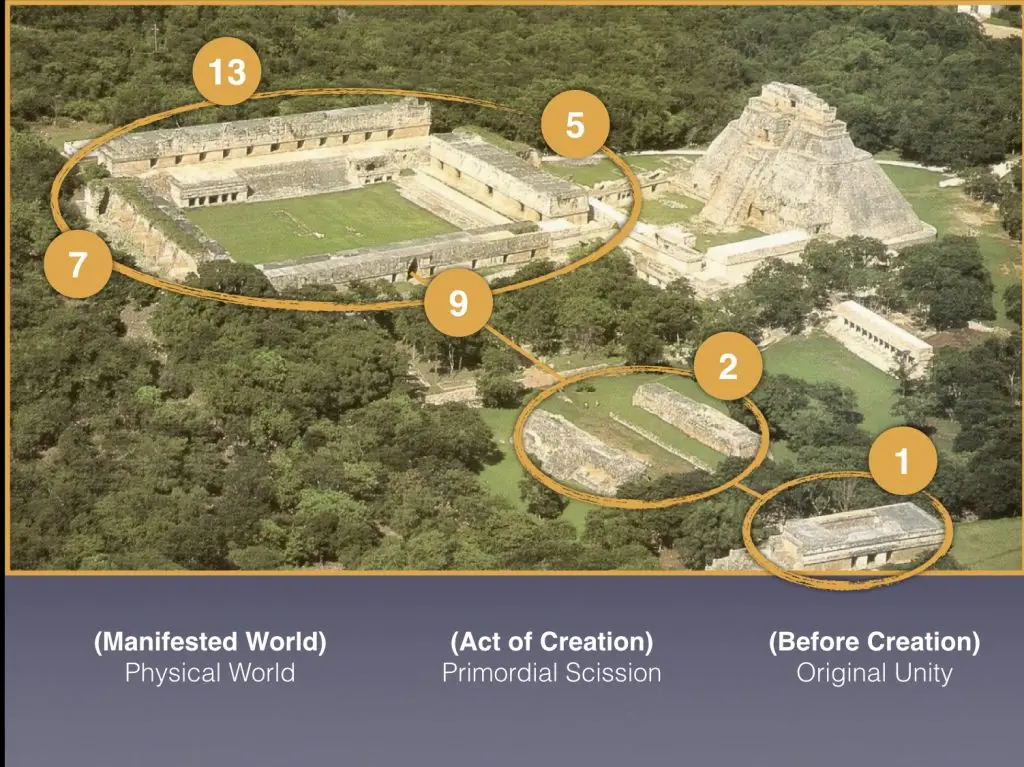
I believe the Nunnery Quadrangle in Uxmal does connect not only to the Ball Court but also to the House of Turtles and I may have discovered the symbolic significance in that relationship. I presented my symbolist interpretation and theory at the 11th Conference on Precession and Ancient Knowledge (CPAK 2019). You can watch the presentation and learn more about my theory here.
To sum it all up, you can see why the Nunnery Quadrangle in Uxmal was a mystery school where teachings not only may have been transmitted orally but were transmitted without a doubt through didactic architecture. The late Maya archaeologist and authority on Maya architecture of International renown, Harry Pollock, describing the Nunnery Quadrangle stated this ‘magnificent building is thought by many to be the finest example of pre-Columbian architecture in the Americas’.
The Nunnery Quadrangle in Uxmal is not only one of the finest examples of pre-Columbian architecture in the Americas, but also an enduring example of the sacred science and the high wisdom of the ancient Maya.
Michael D. Coe, The Maya
Jeff Kowalski, The House of the Governor: A Maya Palace of Uxmal, Yucatan, Mexico
Nikolai Grube, Divine Kings of the Rain Forest
Karl Taube, Major Gods of Ancient Yucatan
Mary Miller and Karl Taube, The Gods and Symbols of Ancient Mexico and the Maya
Pollock, H.E. D. 1980 The Puuc: An Architectural Survey of the Hill Country of Yucatan and Northern Campeche,
Mexico. Memoirs of the Peabody Museum, Vol. 2
Jose Diaz-Bolio, The Geometry of the Maya and Their Rattlesnake Art
John Anthony West, Serpent in the Sky: The High Wisdom of Ancient Egypt
John Anthony West, The Travler’s Key to Ancient Egypt
Migual Angel Vergara Calleros, personal communication
August 19 – 29, 2025
Join bestselling author & ancient mysteries YouTuber Anyextee to explore lost civilizations, uncover ancient enigmas, and awaken your inner seeker — all in 11 unforgettable days across Peru & Bolivia.
September 12 – 23, 2025
Most people only see the surface of Egypt—its pyramids, temples, and artifacts. But there’s another Egypt—encoded in stone, veiled in myth, and reserved for those ready to look deeper. This is your opportunity to peel back the veil.
October 3 – 13, 2025
Join Matt Sibson (Ancient Architects), alongside bestselling author and investigative explorer Anyextee, for an expert-led journey across Turkey—home to some of the oldest and most significant archaeological sites in the world.
November 3 – 18, 2025
Join renowned historian, author, educator and YouTuber, Dr. David Miano for an intellectually rich journey through the heart of ancient Mesoamerica—on this immersive tour of Mexico’s most significant archaeological sites.
August 19 – 29, 2026
Join bestselling author & ancient mysteries YouTuber Anyextee to explore lost civilizations, uncover ancient enigmas, and awaken your inner seeker — all in 11 unforgettable days across Peru & Bolivia.
September 10 – 21, 2026
Most people only see the surface of Egypt—its pyramids, temples, and artifacts. But there’s another Egypt—encoded in stone, veiled in myth, and reserved for those ready to look deeper. This is your opportunity to peel back the veil.